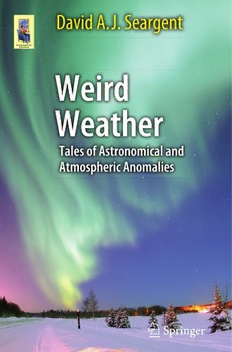
Weird Weather: Tales of Astronomical and Atmospheric Anomalies PDF
Preview Weird Weather: Tales of Astronomical and Atmospheric Anomalies
Astronomers’ Universe For further volumes: http://www.springer.com/series/6960 David A.J. Seargent Weird Weather Tales of Astronomical and Atmospheric Anomalies David A.J. Seargent The Entrance NSW, Australia ISSN 1614-659X ISBN 978-1-4614-3069-8 e-ISBN 978-1-4614-3070-4 DOI 10.1007/978-1-4614-3070-4 Springer New York Dordrecht Heidelberg London Library of Congress Control Number: 2012932204 © Springer Science+Business Media New York 2012 This work is subject to copyright. All rights are reserved by the Publisher, whether the whole or part of the material is concerned, specifically the rights of translation, reprint- ing, reuse of illustrations, recitation, broadcasting, reproduction on microfilms or in any other physical way, and transmission or information storage and retrieval, electronic adaptation, computer software, or by similar or dissimilar methodology now known or hereafter developed. Exempted from this legal reservation are brief excerpts in connec- tion with reviews or scholarly analysis or material supplied specifically for the purpose of being entered and executed on a computer system, for exclusive use by the purchaser of the work. Duplication of this publication or parts thereof is permitted only under the provisions of the Copyright Law of the Publisher’s location, in its current version, and permission for use must always be obtained from Springer. Permissions for use may be obtained through RightsLink at the Copyright Clearance Center. Violations are liable to prosecution under the respective Copyright Law. The use of general descriptive names, registered names, trademarks, service marks, etc. in this publication does not imply, even in the absence of a specific statement, that such names are exempt from the relevant protective laws and regulations and therefore free for general use. Printed on acid-free paper Springer is part of Springer Science+Business Media (www.springer.com) For Meg About the Author David A. J. S eargent holds an M.A. and Ph.D., both in P hilosophy, from the University of Newcastle NSW, where he formerly worked as a tutor in Philosophy for the Department of Community Programs/Workers’ Educational Association external education program. He is also an avid astronomer and is known for his obser- vations of comets, one of which he discovered in 1978. Together with his wife Meg, David lives at The Entrance, north of Sydney on the Central Coast of New South Wales, Australia. He is the author of three published astronomy books; “Comets – Vagabonds of Space” (Doubleday, 1982), “The Greatest Comets in History – Broom Stars and Celestial Scimitars” (Springer, 2008), and “Weird Astronomy – Tales of the Unusual, Bizarre, and Other Hard to Explain Observations” (Springer, 2010). Currently he is the author of a regular column in A ustralian Sky & Telescope magazine. vii Preface It is said that Baden Powell advised anyone hiding from pursuers to climb a tree because people rarely look up! With due respect to tree-climbing escapees, this is a great pity. So many wonders fill our skies. From the far reaches of the cosmos to the air flowing around our heads, the sky is filled with beauty and mystery. Among the Ancients, there existed a cosmology which saw the Universe as divided into three heavens. The First Heaven was described as being where the birds fly or, in our terminology, the atmosphere. The Second was the Heaven of the stars, i.e. outer space or the astronomical universe, and the Third Heaven was the home of the Creator. The First and Second heavens of this old cosmology together make up the sky. All atmospheric phenom- ena, all astronomical events, have their homes there. Some of the spectacles of the sky are well known, others are rare and yet others are truly mysterious. During the course of this book, we will meet members of each class. In this book, we will look chiefly at events within the atmo- sphere – “weather” in the very broadest sense. Yet the gaseous envelope that embraces our world is not an isolated system. Our planet, including its atmosphere, is a part of a far wider environ- ment. There is no clear dividing line between air and space, and nearly all meteorological phenomena have their deep roots in the astronomical. At the most basic level, there would not even be an atmosphere without the Sun’s heat! Our story therefore begins with the Earth in its cosmic set- ting; a lonely blue globe in the vastness of space. The scene looks a hostile one at first glance. Our world appears terribly vulner- able. Yet, as we look more deeply, we see how a wonderful set of circumstances conspires to make our planet the ideal home for a ix
